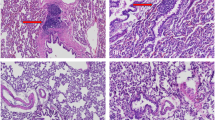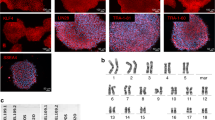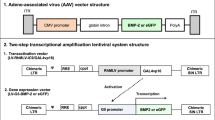Abstract
Cell-mediated and direct adenoviral (Ad) vector gene therapies can induce bone regeneration, including dermal fibroblasts (DFbs). We compared two effective therapies, DFb-mediated and direct Ad vector delivery of bone morphogenetic protein-2 (BMP2), for relative efficacy in bone regeneration. Equine rib drill defects were treated by percutaneous injection of either DFb-BMP2 or an Ad-BMP2 vector. At week 6, both DFb-BMP2- and Ad-BMP2-treated rib defects had greater bone filling volume and mineral density, with DFb-BMP2 inducing greater bone volume and maturity in the cortical bone aspect of the defect than Ad-BMP2. The transplantation of DFb alone induced modest bone formation. Increased mineral density and bone turnover were evident in the cortical and cancellous bone directly adjacent to the healing drill defects treated with either DFb-BMP2 or Ad-BMP2. Using our cell/vector dosage and model, BMP2, whether delivered by the DFb vector or direct Ad vector, induced greater and robust bone regeneration. DFb-mediated BMP2 therapy promoted greater cortical bone regeneration than did direct gene delivery, possibly because of an increased cellularity of the bone healing site. BMP2 delivery, regardless of gene delivery method, increased the mineral density of the neighboring bone, which may be beneficial clinically in repairing or weak bone.
This is a preview of subscription content, access via your institution
Access options
Subscribe to this journal
Receive 12 print issues and online access
$259.00 per year
only $21.58 per issue
Buy this article
- Purchase on Springer Link
- Instant access to full article PDF
Prices may be subject to local taxes which are calculated during checkout






Similar content being viewed by others
References
Evans CH, Ghivizzani SC, Robbins PD . Orthopedic gene therapy in 2008. Mol Ther 2009; 17: 231–244.
Tseng SS, Lee MA, Reddi AH . Nonunions and the potential of stem cells in fracture-healing. J Bone Joint Surg Am 2008; 90: 92–98.
Patterson TE, Kumagai K, Griffith L, Muschler GF . Cellular strategies for enhancement of fracture repair. J Bone Joint Surg Am 2008; 90: 111–119.
Woo SL . From ‘Gene Therapy’ to ‘Gene and Cell Therapy’: why? Mol Ther 2008; 16: 1899–1900.
Betz OB, Betz VM, Nazarian A, Pilapil CG, Vrahas MS, Bouxsein ML et al. Direct percutaneous gene delivery to enhance healing of segmental bone defects. J Bone Joint Surg Am 2006; 88: 355–365.
Betz OB, Betz VM, Nazarian A, Egermann M, Gerstenfeld LC, Einhorn TA et al. Delayed administration of adenoviral BMP-2 vector improves the formation of bone in osseous defects. Gene Therapy 2007; 14: 1039–1044.
Ishihara A, Shields KM, Litsky AS, Mattoon JS, Weisbrode SE, Bartlett JS et al. Osteogenic gene regulation and relative acceleration of healing by adenoviral-mediated transfer of human BMP-2 or -6 in equine osteotomy and ostectomy models. J Orthop Res 2008; 26: 764–771.
Zachos T, Diggs A, Weisbrode S, Bartlett J, Bertone A . Mesenchymal stem cell-mediated gene delivery of bone morphogenetic protein-2 in an articular fracture model. Mol Ther 2007; 15: 1543–1550.
Zilberman Y, Kallai I, Gafni Y, Pelled G, Kossodo S, Yared W et al. Fluorescence molecular tomography enables in vivo visualization and quantification of nonunion fracture repair induced by genetically engineered mesenchymal stem cells. J Orthop Res 2008; 26: 522–530.
Takahashi K, Tanabe K, Ohnuki M, Narita M, Ichisaka T, Tomoda K et al. Induction of pluripotent stem cells from adult human fibroblasts by defined factors. Cell 2007; 131: 861–872.
Hirata K, Tsukazaki T, Kadowaki A, Furukawa K, Shibata Y, Moriishi T et al. Transplantation of skin fibroblasts expressing BMP-2 promotes bone repair more effectively than those expressing Runx2. Bone 2000; 32: 502–512.
Hirata K, Mizuno A, Yamaguchi A . Transplantation of skin fibroblasts expressing BMP-2 contributes to the healing of critical-sized bone defects. J Bone Miner Metab 2007; 25: 6–11.
Krebsbach PH, Gu K, Franceschi RT, Rutherford RB . Gene therapy-directed osteogenesis: BMP-7-transduced human fibroblasts form bone in vivo. Hum Gene Ther 2000; 11: 1201–1210.
Rutherford RB, Moalli M, Franceschi RT, Wang D, Gu K, Krebsbach PH . Bone morphogenetic protein-transduced human fibroblasts convert to osteoblasts and form bone in vivo. Tissue Eng 2002; 8: 441–452.
Lattanzi W, Parrilla C, Fetoni A, Logroscino G, Straface G, Pecorini G et al. Ex vivo-transduced autologous skin fibroblasts expressing human Lim mineralization protein-3 efficiently form new bone in animal models. Gene Therapy 2008; 15: 1330–1343.
Ishihara A, Zekas LJ, Litsky AS, Weisbrode SE, Bertone AL . Dermal fibroblast-mediated BMP2 therapy to accelerate bone healing in an equine osteotomy model. J Orthop Res 2009; 28: 403–411.
Bertone AL, Pittman DD, Bouxsein ML, Li J, Clancy B, Seeherman HJ . Adenoviral-mediated transfer of human BMP-6 gene accelerates healing in a rabbit ulnar osteotomy model. J Orthop Res 2004; 22: 1261–1270.
Egermann M, Lill CA, Griesbeck K, Evans CH, Robbins PD, Schneider E et al. Effect of BMP-2 gene transfer on bone healing in sheep. Gene Therapy 2006; 13: 1290–1299.
Zachos TA, Bertone AL, Wassenaar PA, Weisbrode SE . Rodent models for the study of articular fracture healing. J Invest Surg 2007; 20: 87–95.
Betz OB, Betz VM, Nazarian A, Egermann M, Gerstenfeld LC, Einhorn TA et al. Delayed administration of adenoviral BMP-2 vector improves the formation of bone in osseous defects. Gene Therapy 2007; 14: 1039–1044.
Appledorn DM, Patial S, McBride A, Godbehere S, Van Rooijen N, Parameswaran N et al. Adenovirus vector-induced innate inflammatory mediators, MAPK signaling, as well as adaptive immune responses are dependent upon both TLR2 and TLR9 in vivo. J Immunol 2008; 181: 2134–2144.
Descamps D, Benihoud K . Two key challenges for effective adenovirus-mediated liver gene therapy: innate immune responses and hepatocyte-specific transduction. Curr Gene Ther 2009; 9: 115–1127.
Tian J, Xu Z, Smith JS, Hofherr SE, Barry MA, Byrnes AP . Adenovirus activates complement by distinctly different mechanisms in vitro and in vivo: indirect complement activation by virions in vivo. J Virol 2009; 83: 5648–5658.
McCullough KA, Waits CA, Garimella R, Tague SE, Sipe JB, Anderson HC . Immunohistochemical localization of bone morphogenetic proteins (BMPs) 2, 4, 6, and 7 during induced heterotopic bone formation. J Orthop Res 2007; 25: 465–472.
Sommar P, Pettersson S, Ness C, Johnson H, Kratz G, Junker JP . Engineering three-dimensional cartilage- and bone-like tissues using human dermal fibroblasts and macroporous gelatine microcarriers. J Plast Reconstr Aesthet Surg 2009; (e-pub ahead of print).
Okamoto M, Murai J, Yoshikawa H, Tsumaki N . Bone morphogenetic proteins in bone stimulate osteoclasts and osteoblasts during bone development. J Bone Miner Res 2006; 21: 1022–1033.
Itoh K, Udagawa N, Katagiri T, Iemura S, Ueno N, Yasuda H et al. Bone morphogenetic protein 2 stimulates osteoclast differentiation and survival supported by receptor activator of nuclear factor-kappaB ligand. Endocrinology 2001; 142: 3656–3662.
Koide M, Murase Y, Yamato K, Noguchi T, Okahashi N, Nishihara T . Bone morphogenetic protein-2 enhances osteoclast formation mediated by interleukin-1alpha through upregulation of osteoclast differentiation factor and cyclooxygenase-2. Biochem Biophys Res Commun 1999; 259: 97–102.
Matsuo K, Irie N . Osteoclast-osteoblast communication. Arch Biochem Biophys 2008; 473: 201–209.
Metz LN, Martin RB, Turner AS . Histomorphometric analysis of the effects of osteocyte density on osteonal morphology and remodeling. Bone 2003; 33: 753–759.
McGee ME, Maki AJ, Johnson SE, Nelson OL, Robbins CT, Donahue SW . Decreased bone turnover with balanced resorption and formation prevent cortical bone loss during disuse (hibernation) in grizzly bears (Ursus arctos horribilis). Bone 2008; 42: 396–404.
Tsangari H, Findlay DM, Fazzalari NL . Structural and remodeling indices in the cancellous bone of the proximal femur across adulthood. Bone 2007; 40: 211–217.
Chapurlat RD, Arlot M, Burt-Pichat B, Chavassieux P, Roux JP, Portero-Muzy N et al. Microcrack frequency and bone remodeling in postmenopausal osteoporotic women on long-term bisphosphonates: a bone biopsy study. J Bone Miner Res 2007; 22: 1502–1509.
Livak KJ, Schmittgen TD . Analysis of relative gene expression data using real-time quantitative PCR and the 2(-Delta Delta C(T)) method. Methods 2001; 25: 402–408.
Schefe JH, Lehmann KE, Buschmann IR, Unger T, Funke-Kaiser H . Quantitative real-time RT-PCR data analysis: current concepts and the novel ‘gene expression's CT difference’ formula. J Mol Med 2006; 84: 901–910.
Acknowledgements
We thank Dr Jose Mendez, Dr Phillip Lerche, Dr Turi Aarnes, Dr Eutálio Pimenta, Dr Valerie Samii, Dr Matthew Allen, Rebecca Hancock, David Smith, Archna Hazelbaker and Nancy Weber for technical support. This study was supported by National Institute of Arthritis and Musculoskeletal and Skin Diseases, K08 AR049201.
Author information
Authors and Affiliations
Corresponding author
Ethics declarations
Competing interests
The authors declare no conflict of interest.
Rights and permissions
About this article
Cite this article
Ishihara, A., Zekas, L., Weisbrode, S. et al. Comparative efficacy of dermal fibroblast-mediated and direct adenoviral bone morphogenetic protein-2 gene therapy for bone regeneration in an equine rib model. Gene Ther 17, 733–744 (2010). https://doi.org/10.1038/gt.2010.13
Received:
Revised:
Accepted:
Published:
Issue Date:
DOI: https://doi.org/10.1038/gt.2010.13
Keywords
This article is cited by
-
Systemic administration of mesenchymal stem cells combined with parathyroid hormone therapy synergistically regenerates multiple rib fractures
Stem Cell Research & Therapy (2017)
-
Overexpressing Sonic Hedgehog Peptide Restores Periosteal Bone Formation in a Murine Bone Allograft Transplantation Model
Molecular Therapy (2014)
-
Using genes to facilitate the endogenous repair and regeneration of orthopaedic tissues
International Orthopaedics (2014)
-
Evaluation of an in vivo heterotopic model of osteogenic differentiation of equine bone marrow and muscle mesenchymal stem cells in fibrin glue scaffold
Cell and Tissue Research (2014)
-
Transcription Factor Runx2 and its Application to Bone Tissue Engineering
Stem Cell Reviews and Reports (2012)



